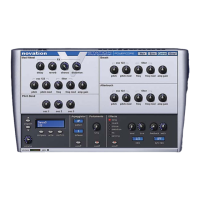Amplifier / Envelopes
Amplifier and Mod envelopes
In earlier paragraphs, it was determined how the pitch and timbre of a sound is synthesised.
This final part of the Synthesis Tutorial describes how the volume of sound is controlled. The
volume throughout the duration of a sound created by a musical instrument often varies greatly
according to the type of instrument.
Note on Note off
Level
Time
An organ sound (above) quickly attains full volume when a key on the keyboard is pressed. It
stays at full volume until the key is released, at which point the volume level falls instantly to
zero.
Note on Note off
Level
Time
A piano quickly attains full volume when a key is pressed and gradually falls back down to zero
after several seconds, even if a key is held.
A string section emulation attains full volume gradually (i.e. it swells in gracefully with a slow
attack) when a key is pressed. It remains at full volume while the key is held down, but once the
key is released, the volume level gradually falls to zero.
On an analogue synthesizer, changes which occur throughout the duration of a note are
controlled by a section known as an Envelope Generator.
Note that on the V-Station, there are no controls in a section on the MAIN panel which deal with
the amplifier directly. The only way to hear and control an audio signal passing through the
amplifier is to modulate it by using Amp Envelope controls.
The V-Station has two envelope generators - one controls overall amplitude, the other controls
the filter (amongst other things).
Each envelope generator has four controls which are used to adjust the shape of the
envelope.

